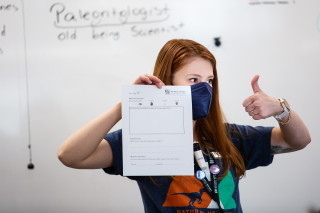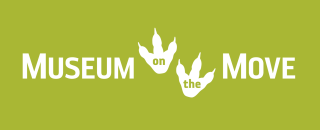Museum on the Move Frequently Asked Questions
What is Museum on the Move? What does a typical class look like?
Museum on the Move is NHMU’s state-funded 4th grade outreach program. When your school is on rotation, you’ll be invited to submit a visit request for your entire grade through our request calendar and choose 90-minute blocks of time for each class, and select a topic.
The 90 minutes with each class consist of an introduction where the NHMU educator reviews the topic and models making and recording observations, questions, and inferences, then the majority of the time is given to students to rotate through stations investigating museum specimens.
How does the rotation schedule work?
As a member organization of the state-funded Utah iSEE Collective, we are committed to offering a visit to every public school district in Utah at least once every three years. We go above and beyond this requirement by offering visits to schools in rural counties every two years, and with generous support from Rio Tinto we can offer visits to schools on the west side of the Salt Lake Valley every year. When it’s your year for a visit, you’ll receive an email with an invitation to choose a date from our request calendar. We rely on district and school websites to contact 4th grade teachers, so you can help us by making sure your contact information is up to date. Check your inbox for an email from Glynis Bawden, gbawden@nhmu.utah.edu or mom@nhmu.utah.edu
Not on rotation this year? We’re happy to add you to our waitlist, and you’re welcome to check out any of the resources listed below!
What other Museum on the Move resources are available while we wait for our visit?
Our Nearpod lessons are available to you any time. These student- or teacher-paced lessons cover the same topics and use the same specimens as our virtual live classes. Your students will have a chance to work as scientists and engineers while learning about science topics and museum specimens.
In addition, we have a series of videos on science and engineering practices that guide students through an object-based investigation while practicing making observations, asking questions, and making inferences. These videos, available both in English and Spanish, can be found here.
Wish you could visit the museum right now? Check out our virtual field trips for videos and activities in each of our galleries. You can spot your Museum on the Move educators in Our Backyard, Great Salt Lake, and Life!
And of course, don’t miss NHMU’s other great teacher resources, from teaching toolboxes to educator workshops, all found on our Educators Webpage.
My school typically does Junior Science Academy. Can we sign up for both Junior Science Academy and Museum on the Move?
At this time, each school can only participate in either Junior Science Academy (at NHMU while on a field trip) or Museum on the Move. We have a lot of schools and students to serve and finite staff resources. We do our best to communicate across the two programs to prevent double-scheduling. If you typically visit for JSA but would like a Museum on the Move visit this year instead, please reach out!
What standards does Museum on the Move cover?
Museum on the Move addresses specific standards in the Utah State Office of Education’s (USOE) Science and Social Studies core curriculum. Each topic focuses on slightly different standards and cross-cutting concepts. For more detailed information on each topic, visit our Museum on the Move Overview page.
Grade 4 Utah Science with Engineering Education (SEEd) Standards:
- Strand 4.1 Organisms functioning in their environment
- Standard 4.1.1 - Structure and function of organisms
- Standard 4.1.3 - Stability and change from fossil evidence
- Standard 4.1.4 - Patterns in rock layers and fossils show change over time
Grade 4 Social Studies:
- Standard I, Objectives 1, 2, and 3 - Students will understand the relationship between the physical geography in Utah and human life
- Standard II, Objectives 1 and 2 - Students will understand how Utah’s history has been shaped by many diverse people, events, and ideas
Museum on the Move engages students in the following Science and Engineering Practices:
- Asking questions and defining problems
- Constructing explanations and designing solutions
- Engaging in argument from evidence
- Obtaining, evaluating, and communicating information
Museum on the Move addresses the following Crosscutting Concepts:
- Structure and function
- Stability and change
I have students that learn best with certain accommodations. What can Museum on the Move offer my students?
We strive to reach all students. We are happy to work with you to provide the best possible experience for your students, whether that consists of additional time, wearing loops, providing guided worksheets for student notes, or sharing a social story in advance. We’re always interested in hearing what will work best for your students.
Scheduling Questions
What does a typical schedule look like?
We spend 90 minutes with each 4th grade classroom, and typically try to fit in three blocks each day.
For example: 9:00 to 10:30 Class 1, 10:45 to 12:15 Class 2, Lunch, 1:00 to 3:00 Class 3
For four or more classes, we always send two educators so we can teach classes simultaneously and fit everyone in. See below for more details about scheduling multiple instructors.
If possible, having built-in transition time between classes helps us start on time. Please do not schedule Museum on the Move during morning announcements or other times that we cannot teach.
Most often, we rotate to each 4th grade classroom. We can also teach in an empty classroom or other quiet space if it can be set up for five station rotations and a whiteboard. Click here to view the full pre-visit checklist and setup instructions.
Do you really need the full 90 minutes?
Yes, we really do need the full 90 minutes! But we promise it’s not 90 minutes of sitting still. Each class includes an introduction to the topic, time to model making observations, rotations around hands-on stations, and a wrap-up discussion. Cutting the time short is like leaving a movie early and will cause students to miss out on stations or important information.
Our bell schedule is limited. What are my options?
We are happy to send multiple educators to help fit into your school day.
If you need two educators, please select a date on the calendar that is available for 6+ classes. If you need three educators, please select a date that is available for 9+ classes.
Can I combine two classes into one time slot?
No, we cannot combine classes if the total number of students will be over 30 because of the station rotations. Instead, please select a date with more availability and we’ll send additional educators.
I don’t know next year’s bell schedule yet. Can I still schedule?
Absolutely! If you do not yet know next year’s bell schedule or all teacher contacts, you can enter placeholders and update the schedule as your visit approaches. It is very easy to make changes and even reschedule, just reach out to mom@nhmu.utah.edu
Which topic should I choose?
It can be a tough choice! You can read the full description of each of our five topics here. Please note that Our Great Salt Lake and Artifacts are subject to availability.
Can we choose more than one topic?
Each 4th grade class can only choose one topic, but different classes can schedule different topics for the same day. It helps to have some extra transition time built into the schedule. If you have multiple classes scheduled simultaneously, only two classes can have Our Great Salt Lake or Artifacts at the same time.
Can I schedule more than one visit?
We can only schedule additional visits after all schools on rotation have been offered the opportunity to schedule. If you would like to be added to a waitlist for a second visit, please make a note in your request or click here to send the School Outreach Manager an email.
How do I prepare for my Museum on the Move visit? What setup do you need?
The most important setup is to prepare five stations for students to rotate. This is typically groups of desks pushed together or tables cleared off. You can read the full setup instructions and pre-visit checklist here. Most often, we rotate to each 4th grade classroom. We can also teach in an empty classroom or other quiet space if it can be set up for five station rotations and a whiteboard.
Do you have materials in multiple languages?
We do! Our guided notes sheets and station cards are available in all Utah Dual Immersion languages. Unless otherwise specified, we will use station cards in English and Spanish.
Do you visit other grades?
NHMU only offers school outreach to 4th grade classrooms, but our friends at other iSEE organizations visit other grades! Click here to learn more about iSEE and the other organizations.

I’m concerned about COVID-19 in my classroom. What accommodations can you offer?
We are happy to adjust Museum on the Move to maintain social distancing and reduce touching shared objects. We can lead students through investigations of 3D models of museum specimens on their individual devices, either in the classroom or via Zoom/Google Meet.
